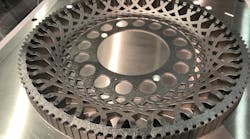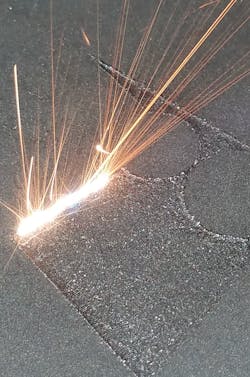Another year down and 3D printing continues to deliver solutions and growth, with no intention of stopping. Looking to the future of printers and materials, we can expect incremental improvements to each. While the technology will have gradual disruption in multiple markets, there won’t be a 3D printing boom in 2019. Nevertheless, as more discover the capabilities of this innovation, it looks like growth will accelerate.
The Printers
HP Metal Jet launched this year, and as with the Jet Fusion, it looks like HP hit the ground running. The Metal Jet is not the first printer like this—Desktop Metal and others offer binder jet process machines. This is a great way to produce parts quickly, and may help companies increase the break-even point on the return on investment when compared to traditional processes.
The main concerns with the binder jet process are the strength of the final part, post-processing, and supply chain. In addition, it is difficult to enter the metal printing world due to the startup cost. You regularly see GE and Concept Laser, Stratasys, Markforged, and now HP working in 3D-printed metal. However, as we learn more we might see more people playing in this market. Xact Metal started on a shoestring budget compared to the bigger companies, but they have already gotten a lot of attention.
Xact Metal was able to produce two models in less than a year: a large version for $120,000 and a smaller version for $80,000. The main difference in this laser powder bed process avoids the use of complex rotating galvanometer mirrors and F-theta lenses.
In traditional laser-based powder bed fusion 3D printers, at least one powerful laser is directed at a series of galvanometer mirrors, which rotate quickly to bounce the beam at a bed of metal powder and fuse the particles together. Although the mirrors are small, the mirror systems themselves are bulky, heavy, and expensive to buy and maintain.
Xact Metal has done away with the galvos and replaced them with what the company calls the “Xact Core”—an X-Y gantry system which sees lighter, less expensive mirrors mounted onto a gantry that moves them in the X- and Y-axes above the powder bed. This keeps the laser at a consistent perpendicular angle to the working surface.
When it comes to metal 3D printing, the most used technology is powder bed process. There are multiple powder bed processes such as binder jetting (BDJ), selective laser melting (SLM), and EBM. Other processes might say selective laser sintering, but they may not be the same as selective laser melting. Sintering normally uses a lower power laser. The energy is enough to compact, but not melt the powder. This might also be a term that is lost in hype and marketing, so it is important to understand whether a company offers sintering, melting, or both.
Aurora labs is another newcomer to the metal printing space. What’s interesting about this printer is that it can carry out multiple processes. According to ANIWAA.com this printer offers three processes: direct laser sinter (SLS), selective laser melting (SLM), and Direct Energy Deposition. At the beginning of the year Aurora’s machine was printing slow. However, the company’s goal is to hit a print speed of one ton of metal per day. On ANIWAA.com’s listing for “The Best Metal Printers of 2019,” Aurora’s printer is listed at $50,000, making it much more cost-effective than the other printers on the list. If the company can increase its print speed Aurora will be interesting to watch in 2019.
SmarTech Publishing’s “2019 Additive Manufacturing Market Outlook and Summary Report” estimates the AM industry grew 24% in 2018 for a total market value of $9.3 billion. The most influential market engagements and moves highlighted in the study included:
- HP’s willingness to bet on its own technology for manufacturing large quantities of parts for its own printers using its own 3D printing process
- Startup Velo3D’s unveiling of its proprietary laser powder bed fusion technology
- The release of the Arcam Spectra-H high temperature electron beam melting system
- Carbon’s production-friendly material pricing strategy
On top of new print features and reducing the price, Partnerships will also drive the 3D printing market in 2019. For example, Optomec acquired Huffman, a leader in metal additive manufacturing for repair. This will deepen Optomec’s penetration into production applications for aerospace and energy markets.
Both Optomec and Huffman deliver a form of metal 3D printing that is known as Directed Energy Deposition (DED; tradename LENS). The company says LENS has distinct advantages over the more widely-known form of metal printing referred to as Powder Bed Fusion (PBF), or Selective Laser Melting (SLM). In particular, LENS is able to print full parts at a fraction of the time and cost of PBF/SLM, yet with better material and mechanical properties. Additionally, LENS is uniquely able to add metal to existing parts for repair and coating applications that extend the useful life of components. While these printers might be working in the background, it will help the energy and aerospace markets in 2019.
In 2019 the 3D printing market will see large companies reduce cost and increase speed, and small companies continue to find innovative way to compete or partner with larger companies. With metal 3D printings continued success and growth, the need for metal powders will inevitably increase. While the printers will be interesting to watch, powder metal companies providing the material in a fast streamline supply chain will also see great gains in 2019.
3D printing in 2019 will see continued growth and expansion. While there are no inherent breakthrough innovations, 3D printing itself has disrupted multiple markets and will continue to do so. This year will be a time to watch who comes out with new features, easier-to-use software, and materials that will push 3D printing into the future.


